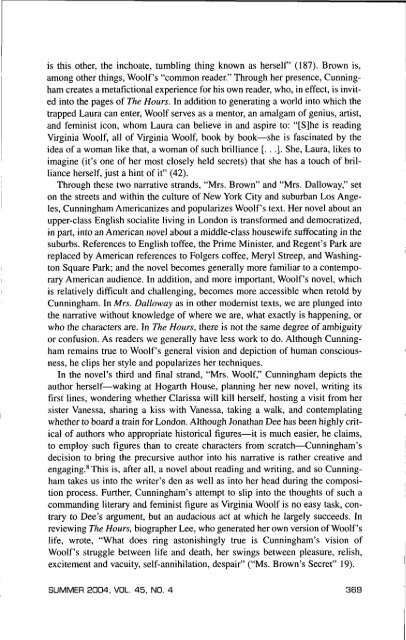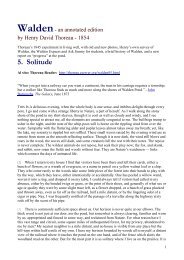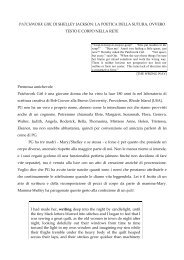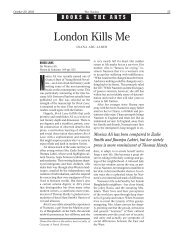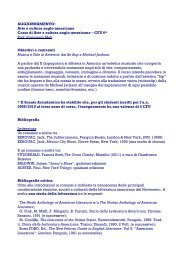Rewriting Woolf s Mrs. Dalloway: Homage, Sexual ... - Paola Carbone
Rewriting Woolf s Mrs. Dalloway: Homage, Sexual ... - Paola Carbone
Rewriting Woolf s Mrs. Dalloway: Homage, Sexual ... - Paola Carbone
You also want an ePaper? Increase the reach of your titles
YUMPU automatically turns print PDFs into web optimized ePapers that Google loves.
is this other, the inchoate, tumbling thing known as herself (187). Brown is,among other things, <strong>Woolf</strong> s "common reader." Through her presence, Cunninghamcreates a metafictional experience for his own reader, who, in effect, is invitedinto the pages of The Hours. In addition to generating a world into which thetrapped Laura can enter, <strong>Woolf</strong> serves as a mentor, an amalgam of genius, artist,and feminist icon, whom Laura can believe in and aspire to: "[S]he is readingVirginia <strong>Woolf</strong>, all of Virginia <strong>Woolf</strong>, book by book—she is fascinated by tbeidea of a woman like that, a woman of such brilliance [...]. She, Laura, likes toimagine (it's one of ber most closely held secrets) that she has a touch of brillianceherself, just a hint of it" (42).Through these two narrative strands, "<strong>Mrs</strong>. Brown" and "<strong>Mrs</strong>. <strong>Dalloway</strong>," seton tbe streets and within tbe culture of New York City and suburban Los Angeles,Cunningbam Americanizes and popularizes <strong>Woolf</strong>'s text. Her novel about anupper-class Englisb socialite living in London is transformed and democratized,in part, into an American novel about a middle-class housewife suffocating in tbesuburbs. References to English toffee, tbe Prime Minister, and Regent's Park arereplaced by American references to Folgers coffee, Meryl Streep, and WashingtonSquare Park; and the novel becomes generally more familiar to a contemporaryAmerican audience. In addition, and more important, <strong>Woolf</strong>'s novel, whicbis relatively difficult and challenging, becomes more accessible wben retold byCunningbam. In <strong>Mrs</strong>. <strong>Dalloway</strong> as in otber modernist texts, we are plunged intotbe narrative without knowledge of where we are, wbat exactly is happening, orwho tbe cbaracters are. In The Hours, tbere is not tbe same degree of ambiguityor confusion. As readers we generally bave less work to do. Altbougb Cunningbamremains true to <strong>Woolf</strong>'s general vision and depiction of buman consciousness,be clips ber style and popularizes ber tecbniques.In tbe novel's tbird and final strand, "<strong>Mrs</strong>. <strong>Woolf</strong>," Cunningham depicts tbeautbor berself—waking at Hogartb House, planning ber new novel, writing itsfirst lines, wondering wbetber Clarissa will kill berself, bosting a visit from bersister Vanessa, sbaring a kiss witb Vanessa, taking a walk, and contemplatingwbetber to board a train for London. Altbougb Jonatban Dee bas been bigbly criticalof autbors wbo appropriate bistorical figures—it is mucb easier, be claims,to employ sucb figures than to create cbaracters from scratcb—Cunningbam'sdecision to bring tbe precursive autbor into bis narrative is ratber creative andengaging.* Tbis is, after all, a novel about reading and writing, and so Cunningbamtakes us into tbe writer's den as well as into ber bead during tbe compositionprocess. Furtber, Cunningbam's attempt to slip into tbe tbougbts of sucb acommanding literary and feminist figure as Virginia <strong>Woolf</strong> is no easy task, contraryto Dee's argument, but an audacious act at wbicb be largely succeeds. Inreviewing The Hours, biographer Lee, wbo generated ber own version of <strong>Woolf</strong>'slife, wrote, "Wbat does ring astonisbingly true is Cunningbam's vision of<strong>Woolf</strong>'s struggle between life and deatb, ber swings between pleasure, relisb,excitement and vacuity, self-annibilation, despair" ("Ms. Brown's Secret" 19).SUMMER 2004, VOL. 45, NO. 4 369


